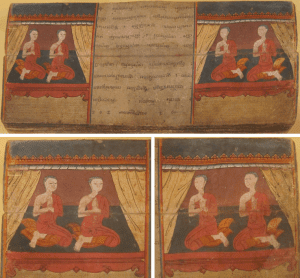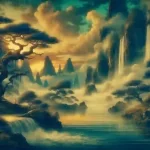All things Indian are exotic , in the West. The western countries are left mesmerised by the richness of tradition and culture that our country offers. Rootedness, the umbilical relationship that we share with our own soil, is something which is unique and hard to come across . However far away we might be residing from our country, this invisible chord binds us , all Indians, together in an unifying spirit. Indians , from time immemorial, had been renowned for upholding family values, the role of women in a family circle, the struggle to fight against all odds . Recent times are witnessing a sharp decline in these moral values. But that is the aftermath of our embracing ‘ the world’s a global village’ hysterics. The world over is a partisan to a social restructuring and our country is no exception.
Indian art , right from the days of the Ajanta frescoes through Raja Ravi Verma and Amrita Sher-Gil to expatriate M.F. Husain, have held viewers, both western as well as eastern, in thrall. It has shown changes over and down the ages. The Ajanta frescoes, talk about early Buddhist Jataka tales. It is but our misfortune that they are in sorry states today. Man’s inclination towards destruction of all things beautiful and the insipient Narcissus in him, have led him on towards innumerable misdeeds. Raja Ravi Verma had humanized mythological figures from our scriptures as well as Hindu gods and goddesses. In his unique style, Verma had brought these deities , to the drawing rooms. Those were days of the British Raj, pre-independence era. He had been conferred the title of ‘Raja’ by the British government. Ketan Mehta, who had made films like Mirch Masala starring Naseerudin Shah, Smita Patil and Shabana Azmi, had recently made the bio-pic Rang Rasiya, on the life and times of Verma. It had , amongst others, Nabaneeta Dev Sen and Amartya Sen’s daughter, Nandana in an important role. The film had raked up a couple of controversies. Not to mention the fact that it had caused a stampede at its screening during the Kolkata Film Festival at Nandan film complex.
The paintings of Amrita Sher-Gil have often been compared to those by Frida Kahlo. Probably because both of them are women and both had led tortured personal lives. On closer look, there indeed seem to be some similarities. Both have painted women, some self-portraits in various moods and habitats. Sher –Gil died before our independence , in Lahore( now Pakistan). Perhaps the latter had been influenced by the works of Kahlo, who knows? The way Sher –Gil had dealt with the human form , most notably the female one, paves the way for comparison between the two of them. We all know that she did not belong to the so called ‘bourgeoisie’. Rather , she had a lavish and opulent upbringing , going abroad to study further. The western influences , found in her works could be accounted for by this fact. But that does not in any way undermine the ‘Indianness’ of her paintings. She had opened up a few voice in Indian painting itself – that of the ‘woman artist’.
Maqbool Fida Husain’s works speak of his deep love for his country, India . Yet he died in a land , far away from it, having forced to forfeit his Indian citizenship. The shenanigans of political power had hounded him to his last days. Despite being a Bohra Muslim, Husain had a deep fascination for and a penchant of Hindu mythology. He had a distinctive style of painting , which can be identified even today , without referring to his signature. The works of these Indian painters fetch huge lump sums of money at auctions , both in India and abroad. Recognition and fame come unto artists’ lives much later in life, if at all. But does anyone wonder at the reason behind a person’s taking up the brush and palette? What prompts a person to become an artist , in the first place? All painters are born artists, but not all artists are born painters. Is it a certain streak in human nature that prompts a man to travel a more-arduous and off-the-beaten-track journey in life?
Art holds up a mirror up to society. Artists are social historians. But how true are artists or painters to the existing social order? Since Indian art has had an immense viewership in the west, one feels that artists should share a sense of commitment , both towards his craft as well as towards his milieu. Blind aping of western traditions and culture would lead us nowhere. Indian contemporary art , especially in the northern and western parts of our country, has lost its ‘rootedness’. Pop art , video and installation art are nothing but our colonial legacies. Artists today are exposed to a wide spectrum of creative talents . Interchange of ideas and ideologies is but inevitable. So a Subodh Gupta installation today, can be labelled as a ‘bridge between the west and the east’. But can anyone find a lineage between this art and the prehistoric cave paintings that have kept men captivated for centuries? Yet both are of Indian origins. Times are changing. And fast. Art as a cultural practice has gained immense momentum in recent years. Today parents proudly state that their son or daughter is a would be or upcoming artist.
An artist depicts what he sees around himself. This is a two-way traffic. The surrounding gets reflected in an artist’s palette. Contemporary Indian art in recent times , only uphold a dystopian vision of the world. It is as though a deep sense of disillusionment has sent in Indian painting. Kitsch abound where subdued metaphors were the salient features found in Indian painting of yester years. There has been a huge churning in the cauldron of our value systems. Man has lost belief – in others, in nature , most importantly, in himself. This loss of directional perspective is seen in through contemporary Indian art produced by young painters. The move has been from a two-dimensional to a four –dimensional approach towards viewership. It is not that there is a paucity of ideas amongst these young artists. But they , somehow, fail in the proper execution of these ideas.
If one chooses a rather difficult and different career option , one is bound to encounter certain pitfalls that the career offers. Without too much compromises, one has to overcome all of them with a dignified stoicism. This is what constitutes the true ‘Indian spirit’. And we should embody this spirit in our art, craft, everything that we may do in our lives. Let us pledge to keep the sensitivity and sublime truths of Indian art alive , by not being a party to mass globalisation.
Indian Review | Authors | Literature & Art | Visit Indian Review for more articles on Art and Literature.
Haimanti Dutta Ray writes on Indian Review.




Leave a Reply